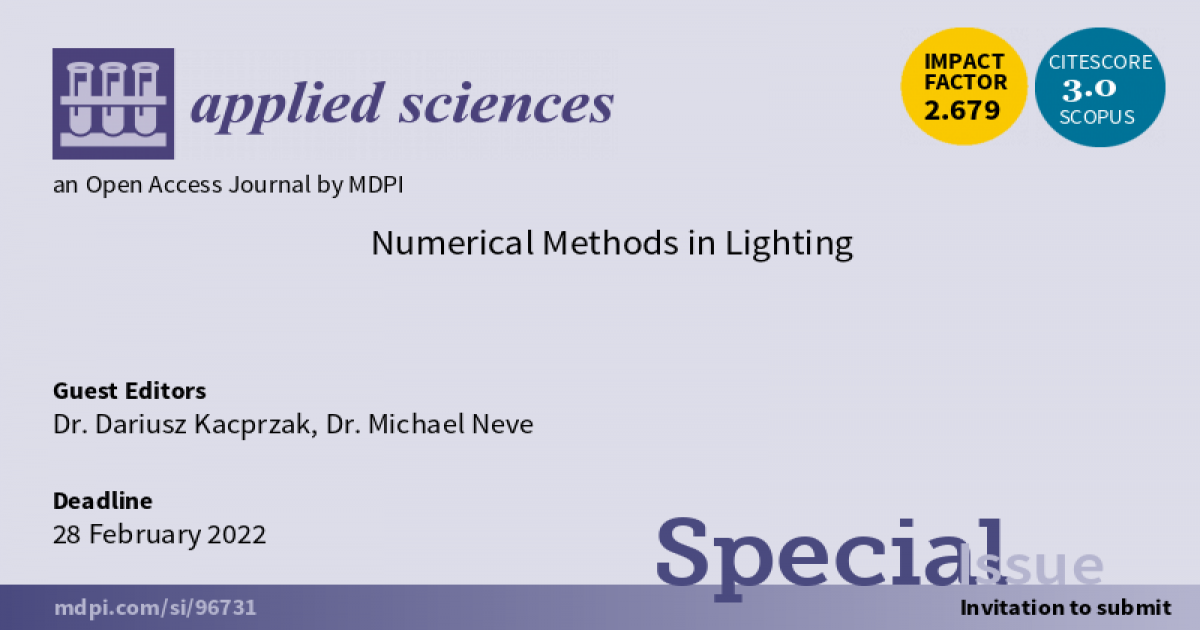Numerical Methods in Lighting
A special issue of Applied Sciences (ISSN 2076-3417). This special issue belongs to the section "Electrical, Electronics and Communications Engineering".
Deadline for manuscript submissions: closed (28 February 2022) | Viewed by 4448

Special Issue Editors
Interests: power transfer system
Interests: radiowave propagation modeling in cellular/microcellular/indoor environments; interaction of electromagnetic fields with building structures; cellular system performance optimization and antennas
Special Issue Information
Dear Colleagues,
The journal Applied Sciences (ISSN 2076-3417, IF 2.679) is running a Special Issue entitled “Numerical Methods in Lighting”. Dr Dariusz Kacprzak and Dr Michael Neve are serving as Guest Editors for this issue.
This Special Issue will present research related to numerical methods used in lighting and lighting system design. The emphasis is on the methods, projection techniques and metrics associated with lighting, human behavior related to lighting, and relevant associated infrastructure. Specific topics are listed below.
Submitted papers should not be under consideration for publication elsewhere.
TOPICS:
- Modeling of artificial lighting
- Modeling of daylight
- Lighting and electromagnetic compatibility
- Visualization techniques in lighting
- Projections and modeling of depreciation methods
- Modeling of glare
- Modeling of lighting for green buildings
- Integrating human behavior metrics in lighting design
- Wireless communications and lighting
Dr. Dariusz Kacprzak
Dr. Michael Neve
Guest Editors
Manuscript Submission Information
Manuscripts should be submitted online at www.mdpi.com by registering and logging in to this website. Once you are registered, click here to go to the submission form. Manuscripts can be submitted until the deadline. All submissions that pass pre-check are peer-reviewed. Accepted papers will be published continuously in the journal (as soon as accepted) and will be listed together on the special issue website. Research articles, review articles as well as short communications are invited. For planned papers, a title and short abstract (about 100 words) can be sent to the Editorial Office for announcement on this website.
Submitted manuscripts should not have been published previously, nor be under consideration for publication elsewhere (except conference proceedings papers). All manuscripts are thoroughly refereed through a single-blind peer-review process. A guide for authors and other relevant information for submission of manuscripts is available on the Instructions for Authors page. Applied Sciences is an international peer-reviewed open access semimonthly journal published by MDPI.
Please visit the Instructions for Authors page before submitting a manuscript. The Article Processing Charge (APC) for publication in this open access journal is 2400 CHF (Swiss Francs). Submitted papers should be well formatted and use good English. Authors may use MDPI's English editing service prior to publication or during author revisions.
Benefits of Publishing in a Special Issue
- Ease of navigation: Grouping papers by topic helps scholars navigate broad scope journals more efficiently.
- Greater discoverability: Special Issues support the reach and impact of scientific research. Articles in Special Issues are more discoverable and cited more frequently.
- Expansion of research network: Special Issues facilitate connections among authors, fostering scientific collaborations.
- External promotion: Articles in Special Issues are often promoted through the journal's social media, increasing their visibility.
- Reprint: MDPI Books provides the opportunity to republish successful Special Issues in book format, both online and in print.
Further information on MDPI's Special Issue policies can be found here.





